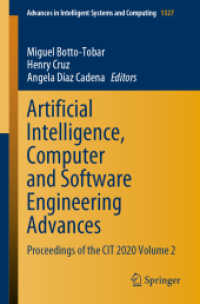- ホーム
- > 洋書
- > ドイツ書
- > Humanities, Arts & Music
- > History
- > antiquity
Full Description
This book presents the latest research and developments in forensic archaeology, as discussed at the European Meetings on Forensic Archaeology (EMFA) from 2018 to 2023. It captures the dynamic and multidisciplinary nature of the field, highlighting the challenges and innovations that have emerged over the last five years.
Divided into three main parts, the book addresses critical aspects of forensic archaeology and its diverse applications. Part I on Forensic Archaeology from the Crime Scene explores cutting-edge methodologies and their application in various forensic contexts. Part II focuses on Forensic Anthropology and Humanitarian Investigations, presenting the study of human remains and the application of forensic archaeology in humanitarian contexts. The final part addresses Heritage Crimes and the role of forensic archaeology in investigating and preventing the illegal trade in artifacts and the destruction of cultural heritage sites.
Contributions from both EMFA presenters and external experts provide a rich tapestry of theoretical advances and practical applications.
This new volume is essential for forensic archaeologists, forensic scientists, law enforcement professionals, and scholars interested in the intersection of archaeology and forensic science. It serves as an important resource for those seeking to understand the complexities of forensic investigations.
Contents
Part I. Forensic Archaeology out of Crime Scenes.- Chapter 1. Cutting-edge Methodologies for Searching Missing Persons.- Chapter 2. Homicide Reconstruction from Metal Paint Particles in Urban Soil.- Chapter 3. Prospects for the development of forensic archaeology in the countries of Central and Eastern Europe.- Chapter 4. Forensic archaeology and anthropology within Swedish law enforcement agencies.- Chapter 5. Hands-on workshops on Forensic Archaeology in Europe: benefits and requirements.- Chapter 6. Forensic Archaeology, Forensic Taphonomy, and Outdoor Crime Scene Reconstruction in America: Personal Perspectives, 40 Years in the Making.- Chapter 7. When forensic entomology becomes essential to document forensic archaeology: enlightening burials with insects.- Part II. Forensic Anthropology and Humanitarian Investigations.- Chapter 8. The Mass Grave Project.- Chapter 9. Complex context - current perspectives on forensic anthropology and taphonomy in Switzerland.- Chapter 10. Investigations into the crimes of the Soviet totalitarian regime in Lithuania - search for the clandestine graves of Lithuanian Freedom Fighters.- Chapter 11. Forensic Archaeological Investigations of the former Mother and Baby Home at Tuam, Ireland.- Chapter 12. Recovering Commonwealth soldiers in France, a forensic archaeology approach.- Chapter 13. The need for forensic archaeology in the investigation of aircraft crash sites.- Part III. Heritage Crimes.- Chapter 14. Forensic Archaeology and Heritage Crimes.- Chapter 15. Heritage Protection by Local Police and Forensic Archaeologists.- Chapter 16. The Human Remains Trade in Spain.







